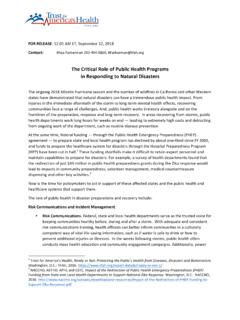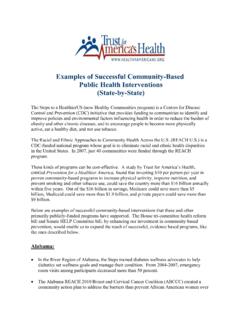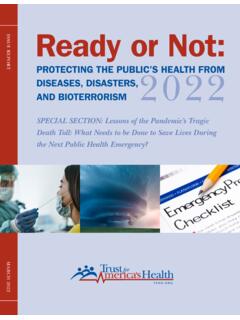Transcription of The State of Obesity: 2021
1 ISSUE REPORTSEPTEMBER 20212021 The State of Obesity: BETTER POLICIES FOR A HEALTHIER AMERICAS pecial Feature: COVID-19, Social Determinants of Health, and Obesity2 TFAH BOARD OF DIRECTORSGail Christopher, of the Board of DirectorsTrust for America s HealthExecutive DirectorNational Collaborative for Health Equity Former Senior Advisor and Vice President Kellogg FoundationDavid Fleming, Chair of the Board of DirectorsTrust for America s HealthTFAH Distinguished Visiting FellowTrust for America s HealthRobert T. Harris, , FACPT reasurer of the Board of DirectorsTrust for America s HealthSenior Medical DirectorGeneral Dynamics Information Technology Theodore Spencer, Secretary of the Board of DirectorsTrust for America s Health Co-FounderTrust for America s HealthStephanie Mayfield Gibson, COVID-19 Response Initiative Resolve to Save LivesCynthia M.
2 Harris, Dean for Public Health and Director and ProfessorInstitute of Public Health Florida A&M UniversityDavid Lakey, Chief Medical Officer and Vice Chancellor for Health Affairs The University of Texas SystemOctavio Martinez Jr., , MPH, MBA, FAPAE xecutive Director Hogg Foundation for Mental Health The University of Texas at Austin John A. Rich, , MPHCo-Director Center for Nonviolence and Social JusticeDrexel University School of Public HealthEduardo Sanchez, , MPHC hief Medical Officer for Prevention American Heart Association Umair A. Shah, , MPHS ecretary of HealthWashington StateVince Ventimiglia, Advocates Leavitt PartnersTFAH LEADERSHIP STAFFJ.
3 Nadine Gracia, , MSCEP resident and CEOREPORT AUTHORSM olly Warren, Health Policy Researcher and AnalystTrust for America s HealthStacy Beck, Lieberman, MPPD irector of Government RelationsTrust for America s HealthCONTRIBUTORSVinu Ilakkuvan, DrPHConsultantSarah Ketchen Lipson, , ProfessorBoston University School of Public HealthAssociate DirectorThe Healthy Minds NetworkREVIEWERSK risty Anderson, MPPS enior Government Relations AdvisorAmerican Heart Association/American Stroke AssociationEduardo Sanchez, , MPHC hief Medical Officer for Prevention American Heart Association Mary Story, , RDProfessor of Global Health, and Family Medicine and Community HealthDuke UniversityAssociate Director for Academic ProgramsDuke Global Health InstituteDirectorHealthy Eating Research National Program, Robert Wood Johnson FoundationAcknowledgmentsTrust for America s Health (TFAH)
4 Is a nonprofit, nonpartisan public health policy, research, and advocacy organization that promotes optimal health for every person and community, and makes the prevention of illness and injury a national priority. The Robert Wood Johnson Foundation (RWJF) provided support for this report. Opinions in it are TFAH s and do not necessarily reflect the views of State of ObesityTABLE OF CONTENTSSEPTEMBER 2021 Table of ..4 SECTION 1. SPECIAL FEATURE: COVID-19, OBESITY, AND SOCIAL DETERMINANTS OF HEALTH .. 8A. Weight Gain and Obesity Rates During the COVID-19 Pandemic.
5 10B. Shifting Conditions During the COVID-19 Increases in Food Insecurity, Changes in Eating Habits, and Decreases in Physical Activity During the Pandemic ..14D. Policy Changes in Response to COVID-19 Pandemic ..15Q&A with Angela Odoms-Young, 2. OBESITY-RELATED DATA AND Trends in Adult i. State Obesity Rates ..19 ii. Demographic Trends in Childhood Obesity ..25 i. National Youth Obesity ii. Young WIC Participants Ages 2 to iii. Obesity Rates in Children and Teenagers, Ages 10 to 17 ..27 iv. High School Obesity Rates ..27 SECTION 3. OBESITY-RELATED POLICIES AND PROGRAMS.
6 29A. Economics of What We Eat and i. Fiscal and Tax Policies that Promote Healthy Eating: Beverage Taxes, Healthy Food Financing Initiative, and the New Markets Tax ii. Food and Beverage Marketing ..31B. Nutrition Assistance and i. Federal Hunger and Nutrition Assistance: WIC, School/Child Nutrition Programs, SNAP, and Nutrition Incentive ii. Child Care and Education Settings: Head Start, Early Childhood Education State Requirements, K-12 Local Wellness Programs, and Smart iii. Dietary Guidelines, Nutrition Facts, and Calorie Labels ..43C. Community Policies and Programs.
7 44 i. Built Environment: Community Design and Land Use, Housing, and Safe Routes ..44 ii. CDC Community Initiatives ..46D. Healthcare Coverage and Programs ..50 i. Medicare and Medicaid ..50 ii. Healthcare and Hospital 4. : OBESITY-RELATED INDICATORS AND POLICIES BY State .. this report online at For more data on childhood obesity, visit The State of ObesityINTRODUCTIIONINTRODUCTIONSEPTEMBE R 2021 Introduction The COVID-19 pandemic added new obstacles and exacerbated existing barriers to healthy eating and physical activity in 2020 and 2021, and deepened longstanding racial and economic inequities in the United States.
8 Emerging data suggests eating habits shifted, physical activity declined, stress and anxiety increased, food insecurity worsened, and many Americans gained weight throughout the pandemic, a sharp reminder of the effects that underlying social, economic, and environmental conditions have on the health and well-being of Americans. Many of direct and indirect effects of the pandemic fell disproportionally on certain populations, including low-income communities and communities of color. These more recent changes are on top of a decades-long rise in obesity rates across the United States, with the adult rate passing 40 percent nationally for the first time in 2017 2018, according to the National Health and Nutrition Examination Survey (NHANES).
9 Since 1999 2000, the adult obesity rate in the United States has increased 39 ,2 State -level data from the Behavioral Risk Factor Surveillance System (BRFSS) confirm the trend that adult obesity rates continued to climb in many states in 2020. In 2020, adult obesity rates topped 35 percent in 16 states, up from 12 states in 2019. Between 2015 and 2020, half of states (26) had statistically significant increases in their adult obesity Percent of Adults and Youth with Obesity, 1988 2018 01020304050 Percent of Youth Age 2 19 with ObesityPercent of Adults (Age 20+) with Obesity2017-20182015 20162013 20142011 20122009 20102007 20082005 20062003 20042001 20021999 20001988 : NHANES5 TFAH response to long-term increases in obesity plus additional harm from COVID-19, the United States needs bolder policies and more investment in long-term, evidence-based programs that reduce obesity.
10 More collaboration across public and private sectors; more innovation and better solutions to the obesity crisis; and continued attention and more action on addressing the underlying conditions and structural and systemic inequities that undermine many Americans health. This is the 18th annual report by Trust for America s Health on the obesity crisis in the United States. This year, our special feature highlights the interaction of the COVID-19 pandemic with social, economic, and environmental conditions that have changed eating habits, food insecurity rates, physical-activity patterns, and obesity levels.




